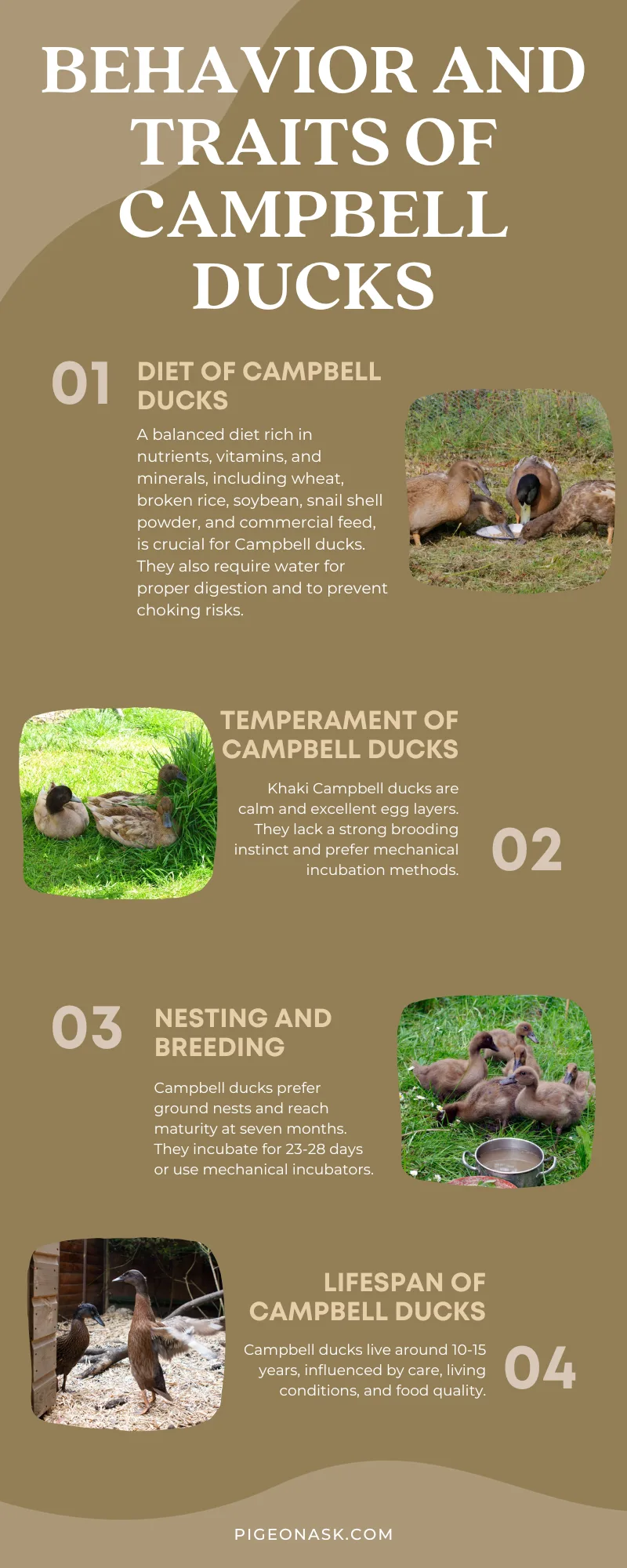Campbell Duck: History And Breed Guide
When it comes to productive ducks, few are as good as the Campbell duck. This duck breed offers incredible fertility to lay over 300 eggs yearly, effectively being one of the most profitable breeds.
Plus, these ducks are independent. They will raise their ducklings and forage for food. As a result, the Campbell duck is an ideal breed if you’re a beginner farmer.
In this article, we will discuss everything related to the process of breeding and raising Campbell ducks. Do you want to increase your odds of breeding these ducks successfully? Here’s how you do it.

Looking for more articles about duck breed:
Campbell Duck Profile
| Name | Campbell Duck |
|---|---|
| Scientific Name | Anas platyrhynchos domesticus |
| Common Names | Khaki Campbell Duck |
| Origin | United Kingdom |
| Size | Small to Medium |
| Weight | Drake 5 to 5.5 Pounds Hens 4.4 to 5 Pounds |
| Lifespan | 10 to 15 Years |
| Feather Color | Khaki, Dark, White |
| Climate Tolerance | High |
| Behavior | Calm |
| Breeding and Maintenance | Easy |
| Easy to Keep? | Yes |
| Duck Purpose | Egg Production |
| Egg Productivity | Elevated |
Overview
Cambell duck is a breed of domestic ducks developed in the United Kingdom. Currently, farmers breed this duck due to its elevated egg productivity.
Additionally, this duck provides decent amounts of meat and can be pleasant pets at home.
History and Origins of Campbell Ducks
The origin of Campbell ducks dates back to 1887. This year, Mrs Adele Campbell started her poultry-keeping career, which eventually led her to use the Indian Runner Duck as the base for Campbell ducks.

According to Mrs. Campbell, this duck breed is the result of mating different Rouen, Indian Runner and Wild Duck.
This crossing produced efficient egg layers and the breeder presented the “Campbell” to the public in 1898.
But that was far from the end. Mrs. Campbell wanted to develop a more attractive plumage and she proceeded with more cross-mating practices to reach this end.
She thought the resulting color resembled the British Army uniform and that’s why the name is “Khaki Campbell Duck.”
In 1923, Dr. Arthur Campbell, Mrs. Adele’s husband, became president of The Khaki Campbell Duck Club. Then, the duck breed satisfied the Standards of the Poultry Club in the UK in 1924.
The next relevant date is 1941, which was the introduction of the breed to the American Standard of Perfection.
Currently, the American Livestock Breeds Conservancy lists the Campbell duck under the “watch” classification.
Physical Characteristics and Features
Campbell ducks are of medium size (1.5 to 2 feet in height), typically weighing less than 5 pounds. They have long necks and green or black bills. Also, the plumage has dark streaks that are easy to identify.

Feather Colors
Campbell ducks have khaki plumage with dark and brown heads. Typically, the feathers can be four colors, which are khaki, pied, white and dark.
Differences Between Campbell Ducks and Campbell Drakes
You can tell the difference between male (drakes) and female (hens) Campbell ducks because of their physical appearance.
Males have dark orange shades on legs and feet, whereas females have a brownish color. Similarly, the drake’s head is darker in color when compared to the head of hens.
Another difference is the body build, as drakes are usually larger.
Behavior and Traits of Campbell Ducks
Campbell ducks are fascinating birds. They are among the most productive and some of the easiest to raise. Without a doubt, it’s these attributes that will allow you to make the most productivity out of these birds.

Here’s what you can expect.
Diet
A proper feeding regimen is essential to increase your odds of raising productive ducks with a higher egg-laying rate. Therefore, you must provide balanced food rich in nutrients, vitamins and minerals.
A common food in the diet of Campbell ducks include wheat, broken rice, black sesame, soybean, snail shell powder and typical commercial feeding products.
Likewise, these ducks can consume chicken and feed crumble or pellets to avoid choking risks.
Lastly, remember to provide water. This duck breed consumes a considerable amount of water, which also helps them to eat without choking.
Temperament
Campbell ducks are docile. They are calm and quiet, two characteristics that make these ducks fun to raise. Another fascinating trait is that the females are excellent mothers but not overly protective of their eggs.
Why Khaki Campbell Ducks Take a Laid-Back Approach to Their Eggs
Khaki Campbell ducks, although excellent mothers exhibit a unique laid-back attitude when it comes to their eggs.
This behavior is a result of selective breeding, focusing on prolific egg-laying rather than brooding instinct.
In most cases, mechanical incubators or broody chickens are used to hatch their ducklings, as these ducks aren’t inclined to be overly protective of their eggs.
While they excel in nurturing their ducklings, their hands-off approach to eggs is a testament to the intriguing world of avian behavior.
Nesting and Breeding
This breed of ducks does not require complicated nesting conditions.
Usually, Campbell ducks are content with building a nest around the coop’s ground instead of over a roost. For this reason, you must provide the materials to make the nest assemble easier, like leaves and grasses.
Breeding
Campbells reach maturity at seven months old. The females usually focus on hatching their own eggs, but they can hatch larger broods in a communal situation.
Still, the ducks are not overly protective of the eggs. So you will have an easy time collecting them.
Incubation of Campbell duck eggs takes from 23 to 28 days until hatching. During this range, you must inspect the eggs regularly to ensure the ducklings emerge safely.
Also, if there are no ducks during incubation, a mechanical incubator or broody chickens can complete the process.
Lifespan
The average lifespan of Campbell ducks is between 10 and 15 years. How long the ducks live depends on multiple factors, like living conditions, protection and food quality.
Caring for your ducks appropriately will increase their likelihood of living more years.
Breeding and Raising
The Campbell duck is one of the most productive ducks to breed and raise.
These ducks lay hundreds of eggs yearly and the meat is delicious.

Additionally, the whole process is a breeze due to the personality of this bird. Here’s what you need to know –
Some Tips and Considerations for Successful Breeding
- Get your hens and drakes from a renowned seller. Otherwise, you will risk getting low-quality Campbell ducks.
- Make sure the ducks are in good health. If you notice a duck is ill or behaving erratically, don’t use it for breeding and remove it from the flock.
- This duck breed is excellent at parenting. Thus, you don’t have to intervene excessively. The hens will raise the ducklings just fine.
- Keep the breeding pair together in a designated area and don’t separate them.
Feeding and Housing Requirements
The ideal housing for Campbell ducks is either a duck house or a duck coop. Once you choose the preferred option, assign at least three square feet of ground space per duck.
Ventilation is also necessary to secure comfortable living conditions.
Campbell ducks like to explore, meaning that water sources like ponds would be good entertainment for them. However, their resting place must be secure to avoid predators or risks of losing laid eggs.
Feeding
Feed your Campbell ducks twice daily, in small amounts each morning.
By night, check if the ducks ate the food you provided during the day. If you notice that the ducks failed to eat all the food, reduce the amount for the next day.
The Egg Productivity of Campbell Ducks
Over the years, the Campbell Duck has become one of the most popular egg layer breeds. Hens can lay from 300 to 320 eggs yearly and the eggs are extra-large.

Such a productivity level means a single hen could lay one egg daily. The eggs are rich in protein and suitable for all the usual applications.
Does that mean that Campbell ducks are ideal for egg businesses? Yes, absolutely. In fact, egg productivity is the primary reason behind the popularity of this breed.
The Meat Quality and Popularity of Campbell Ducks
The meat quality of Campbell ducks is high. It’s tasty, moist and considerably demanded in the market.
Nonetheless, the low weight of the ducks affects how much meat you can get. Plus, the lack of fat is another reason people don’t raise these ducks for meat.
Frequently Asked Questions
- Are Campbell ducks good pets?
Generally, Campbell ducks are docile and calm birds, meaning they could be good pets. If there are children in the household, the ducks will get along and bond well with them and adult humans.
- How much do Campbell ducks cost?
Campbell ducks cost between $8 and $16. Males are usually between $8 and $9, whereas the price for females starts at $15. If you buy in dozens, the price is lower.
- Are Khaki Campbell ducks noisy?
No, Campbell ducks are not noisy. The ducks will quack when hungry, but not too loud or anything out of the ordinary compared to other breeds. Keep them fed and care for them and the Campbell ducks will be quiet.
Conclusion
Every positive thing you’ve heard about the Campbell duck is probably correct. In this article, we explored the multiple reasons why this breed of duck is one of the most satisfying to raise as layers.
Sure, you can’t get a lot of meat out of this duck, but the high egg production rate compensates for it.
Found this article fascinating? Stay connected with us on Facebook, Twitter and Pinterest to learn more about ducks and birds in general.
References:
- https://www.omlet.co.uk/breeds/ducks/campbells
Image Credits:
- https://www.instagram.com/jrg._photography/
- https://www.instagram.com/briarpatchfarm_/
- https://www.instagram.com/ftv.photography/






